Jerald S. Altman's Blog, page 2
April 28, 2015
Top 5 Tips for Preventing Swimmer’s Ear
Swimmer’s ear is a medical condition that results in significant pain as a result of irritation, inflammation, or infection in the ear. Its name is based on the fact that it normally affects swimmers. It typically affects children as well as teenagers, but can also have an effect on people with eczema.
The pain is reduced through medication while the person undergoes treatment and waits for the infection to heal. Read on to find out the top 5 tips to prevent the infection in the first place.
1. Keep the ears dry
After your ears are exposed to water from swimming, bathing, or any activity involving water, dry them thoroughly by wiping the outer ear gently using a soft cloth. Tip the head from one side to another gently and steadily to allow the water to drain out.
2. Swim wisely
Watch for any signs that alert swimmers to a high bacteria count and avoid swimming on such days. Swimming advisories are normally issued in such cases – keep an eye (or ear) open for them!
3. Protect the Ear from Any Irritants
Swimming pools normally contain chemicals to kill bacteria. However, any type of chemical can turn out to be harmful, especially if the water gets trapped inside the ears. Consider using ear plugs while swimming to prevent water from getting in.
4. Avoid Inserting Foreign Objects
Never try to insert foreign objects into the ear canals, such as cotton swabs or hairpins, to clean the earwax. This can irritate your skin, break it, and even rupture the eardrum in certain cases, increasing the chances of developing an infection.
5. Get Your Ears Cleaned by an Otolaryngologist
It is a good practice to have the ears checked and cleaned by an Otolaryngologist once in a while if you have problematic ear wax, or if you have scaly ears or flaky and itchy skin.
The post Top 5 Tips for Preventing Swimmer’s Ear appeared first on .
April 21, 2015
Top 5 Tips to Save Children from Ear and Nose Foreign Bodies
It’s very common for kids to stick things where they don’t belong: namely the nose and the ears. The list of things they insert just keeps continues to grow, from candy to rocks to beads and buttons. All of these foreign bodies can lead to some serious health issues, including blocked airways, nosebleeds and punctured eardrums.
Removing these objects from where they don’t belong is another thing; but avoiding such situation in the first place has its own merits. This is why parents should take all preventive measures possible to shun such possibilities. Read on to find out the top 5 tips to save children from foreign bodies.
1. Observe from a Child’s Perspective
Look at your home from the point of view of your child. Think about where they could go, what they could do with things lying around the house and so on.
It’s wise to check low tables, floor, and below the furniture for toys, furniture and keys along with other tiny objects.
2. ‘Keep out of reach of children’
There’s a reason this statement is mentioned on medicines. Keep all small objects away from reach of children. Install child-proof locking mechanisms on cupboards and containers.
3. Keep the Trash Away
Toddlers don’t have any dislike of digging into trash. Keep the trash in a place that is inaccessible to them, particularly when it contains small objects that you have thrown away.
4. Watch As They Eat
It’s not just beads and buttons that children insert up their nose and into their ears. They can do the same with the food they eat. Peas, sweet corn, and beans are some of the common things extracted from the nasal and ear cavities. Keep your eyes on them when they’re eating.
5. Talk to them
It is a good idea to have a family discussion with children who can talk and understand. Let them know how dangerous it is to stick things up their nose and ears. A pep talk can work wonderfully!
Jerald S. Altman, M.D. is an Otolaryngologist-Head and Neck Surgeon (ENT doctor) and is the coauthor of Don’t Stick Sticks Up Your Nose! Don’t Stuff Stuff In Your Ears! He was recognized as a Phoenix Top Doc in 2010, 2011, 2012, and 2013. Dr. Altman loves taking care of children’s ear, nose, and throat issues. After publishing many peer-reviewed journal articles, he recognized the need for a children’s book dealing with a common problem in his practice.
Check out our website at www.dontstickdontstuff.com. Follow @dontstickdont on Twitter and “Like” us at Don’t Stick Sticks Up Your Nose! Don’t Stuff Stuff In Your Ears! on Facebook. For questions, contact Dr. Altman at Jerry@dontstickdontstuff.com
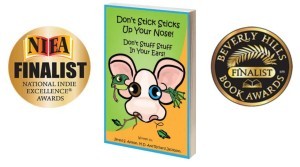
The post Top 5 Tips to Save Children from Ear and Nose Foreign Bodies appeared first on .
April 2, 2015
Summertime Care of Tympanostomy Tubes
 Statistics show that every year almost half a million children undergo surgeries under anesthesia in which ear tubes are inserted into their ear drums. The surgery is performed under general anesthesia and is carried out to remove any fluid that may have become trapped behind the ear drum and to prevent recurrent ear infections. A few other reasons exist, but these two are the more common.
Statistics show that every year almost half a million children undergo surgeries under anesthesia in which ear tubes are inserted into their ear drums. The surgery is performed under general anesthesia and is carried out to remove any fluid that may have become trapped behind the ear drum and to prevent recurrent ear infections. A few other reasons exist, but these two are the more common.
The purpose of the tube is to ensure that the pressure reaches the same value on both sides of the ear drum; hence preventing the fluid from building up in the child’s middle ear, preventing loss of hearing and significantly reducing the risk of any ear infections. This procedure is also carried out if an infection persists despite an antibiotic therapy.
Changes in Guidelines
Previously, it was recommended that those children who had these tubes inside their ears, had to wear ear plugs whenever involved in any water activities, including when taking a shower, bath, or swimming.
Following these guidelines, many children wore ear plugs especially when swimming to keep the water out of their ear canal as well as out of the tube itself. It has been found that the water typically does not enter the tube during swimming, leading to a change in the guidelines for children with tympanostomy tubes.
It is now a fact that the majority of children need not wear ear plugs when swimming. Nonetheless, it is still recommended that they do so under the following conditions:
When experiencing discomfort or pain or discomfort if water enters their ear canal
If a discharge/drainage is seen from their ear canal
If there are frequent or extended episodes of drainage from ears
There are other instances where ear plugs may be required for use by children when:
They are swimming at a depth of more than 6 feet
They are swimming in non-chlorinated pools, or lakes
They are dunking their head in the bath tub (problems can be caused due to soapy water)
With that said, the individual case should be observed and the child should be allowed into the water without earplugs only if the above situations do not exist.
Jerald S. Altman, M.D. is an Otolaryngologist-Head and Neck Surgeon (ENT doctor) and is the coauthor of Don’t Stick Sticks Up Your Nose! Don’t Stuff Stuff In Your Ears! He was recognized as a Phoenix Top Doc in 2010, 2011, 2012, and 2013. Dr. Altman loves taking care of children’s ear, nose, and throat issues. After publishing many peer-reviewed journal articles, he recognized the need for a children’s book dealing with a common problem in his practice.
Check out our website at www.dontstickdontstuff.com. Follow @dontstickdont on Twitter and “Like” us at Don’t Stick Sticks Up Your Nose! Don’t Stuff Stuff In Your Ears! on Facebook. For questions, contact Dr. Altman at Jerry@dontstickdontstuff.com

The post Summertime Care of Tympanostomy Tubes appeared first on .
March 18, 2015
KIRKUS REVIEW: In their debut, co-authors Altman and Jacobson explain to young readers the appropriate uses for the nose, ears and mouth
 KIRKUS REVIEW
KIRKUS REVIEWby Jerald S. Altman, Richard Jacobson
In their debut, co-authors Altman and Jacobson explain to young readers the appropriate uses for the nose, ears and mouth—and what should go in them and what should not.
Breakfast foods, like bacon and fried eggs, do not go in the ears or nose. Neither do toy cars, bumblebees, chopsticks, stones, small animals, or art supplies—no matter how tempting it is to poke them up the nostril or through the ear canal. And why not? For one thing, “Ears have really small holes that lead into your head // Sounds should enter in them and never stuff like bread!” Plus, it scares doctors and parents and causes pain. Instead, the authors explain that the nose is just for smelling and the ears just for hearing. The short book turns to many examples to drive home its message, in both text and illustrations. Young children will find these examples familiar and comical—the perfect combination to emphasize a point to the age group most likely to squeeze a straw or crayon where they shouldn’t. Continue reading this review …
The post KIRKUS REVIEW: In their debut, co-authors Altman and Jacobson explain to young readers the appropriate uses for the nose, ears and mouth appeared first on .
February 25, 2015
Consequences of Foreign Bodies in Ears and Nose | Don’t Stick Don’t Stuff
The Dangers of Foreign Bodies in Noses and Ears –
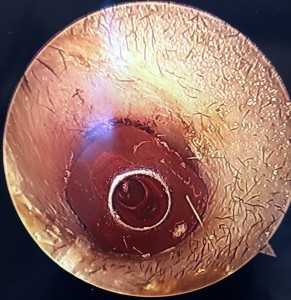
This is a bead as it sat in the child’s ear canal
Young children, out of curiosity, often insert small objects in their nose and ears. They do this out of innocence, curiosity, and a bid to explore their bodies. It is important for adults to understand that such actions can lead to serious health problems, especially when these objects are pushed deeper into the ear canals and nose cavities.
Beads, raisins, and cotton are among the common things that pose great danger to children. The nose is surprisingly deep, and an inserted object can remain there for quite some time before a parent becomes aware of the issue.
Infection and bleeding are the major indicating factors that something may be lodged in the nose. Discolored and foul smelling drainage are signs that an infection caused by a foreign object is in the nose. Nose bleeds are known as epistaxis. While nose bleeds are normally not life threatening, attention needs to be paid to ensure it is not being caused by a lodged object inside the child’s nose.
Children can also insert objects such as beads and peas in their ears. The item can be lodged further inside as they insert their finger inside, trying to overcome the uncomfortable feelings. In many instances, the removal of inserted objects becomes difficult even for doctors as children do not cooperate.
In such cases, anesthesia has to be used and the procedure to extract the object is performed in the operation room (OR). The costs incurred can be quite significant, not to mention the hassle as parents have to miss work in order to take their child to the clinic.
Care needs to be taken to ensure that such tiny objects are placed out of reach of children and that children are observed continuously when playing with toys containing small parts so that such concerns can be avoided in the first place.
Jerald S. Altman, M.D. is an Otolaryngologist-Head and Neck Surgeon (ENT doctor) and is the coauthor of Don’t Stick Sticks Up Your Nose! Don’t Stuff Stuff In Your Ears! He was recognized as a Phoenix Top Doc in 2010, 2011, 2012, and 2013. Dr. Altman loves taking care of children’s ear, nose, and throat issues. After publishing many peer-reviewed journal articles, he recognized the need for a children’s book dealing with a common problem in his practice.
Check out our website at www.dontstickdontstuff.com. Follow @dontstickdont on Twitter and “Like” us at Don’t Stick Sticks Up Your Nose! Don’t Stuff Stuff In Your Ears! on Facebook. For questions, contact Dr. Altman at Jerry@dontstickdontstuff.com

The post Consequences of Foreign Bodies in Ears and Nose | Don’t Stick Don’t Stuff appeared first on .
February 10, 2015
Ethiopia and Medicine – What can we do?
I wanted to venture off into another topic, but one not far from this blog. I plan to fly off in different directions periodically because other things are important to talk about. I have been to Ethiopia 4 times in 3 years and will be going back this year, probably in May 2015. If you haven’t been there, this video can give you a glimpse into the roads and drivers. This is a time-lapse video but once you see it, you will remember it when you leave there.
On the surface, Ethiopia looks like you might expect it (to in some places- but it isn’t like this everywhere) and it won’t look this for long.
There is so much work being done to develop infrastructure throughout the country, you might be surprised as you walk around Addis Ababa. Roads are being paved, buildings are being built (check out the scaffolding!), stores and restaurants are open and the city looks vibrant! And while the country is being developed, there are areas that need to stay as they are in order to protect the rich history and significance.


 One of these areas is Lalibela. In Lalibela there are 11 churches that were built as a symbolic representation of Jerusalem. Lalibela is known for these churches that were not actually BUILT, but were each carved and chiseled out of the mountain.
One of these areas is Lalibela. In Lalibela there are 11 churches that were built as a symbolic representation of Jerusalem. Lalibela is known for these churches that were not actually BUILT, but were each carved and chiseled out of the mountain.
The best known is the Church of St. George that was excavated (40 feet down) instead of constructed. This church was built after King Lalibela’s death. Enough history… but such a fascinating destination you have to see them in person.
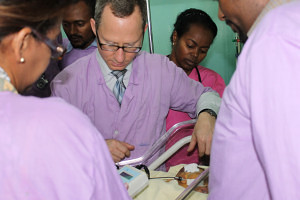
Jerald Altman, MD working with Sophia Mengistu, MD and her NICU team. Teaching how to use an Otoacoustic Emission hearing screener
Just as Addis Ababa and surrounding cities are being modernized, so is the medicine. Residents are being trained both in Ethiopia and other countries. Equipment is improving, health is improving and lives are being saved. Although sometimes equipment that is donated by well-meaning individuals becomes non-usable because it breaks or a fuse is bad, or an expensive light bulb wears out (that is expensive and not available), it doesn’t mean that equipment shouldn’t be donated. For the time that the equipment is used, patients are being helped and the doctors are given the opportunity to learn to use the equipment that will find its way back to them again in the future.
Medical missionaries travel to Ethiopia to teach and work aside physicians, nurses, technicians, medical assistants and everyone else who is working to improve the health of Ethiopians. The medical missions are organized and originate from many different countries of the world. Additionally, there are many countries and non-governmental organizations who provide enormous financial assistance to Ethiopia and not less importantly, there are MANY smaller groups who give their time, effort and money to improve the lives of the people in Ethiopia.
Finally, I titled this post, What can we do? The answer is obvious. Though it doesn’t have to take place in Ethiopia.
1) Volunteer at a local food shelter or home for the aged.
2) Work at a free health clinic, homeless shelter, animal shelter or participate in building projects in your area.
3) Donate supplies to organizations, participate in fund-raising events or donate your own funds.
4) Travel to another city, state, or country and donate your time, effort, supplies, money or knowledge.
5) There are many other things to do to help. Just do SOMETHING.
Jerald S. Altman, M.D. is an Otolaryngologist-Head and Neck Surgeon (ENT doctor) and is the coauthor of Don’t Stick Sticks Up Your Nose! Don’t Stuff Stuff In Your Ears! He was recognized as a Phoenix Top Doc in 2010, 2011, 2012, and 2013. Dr. Altman loves taking care of children’s ear, nose, and throat issues. After publishing many peer-reviewed journal articles, he recognized the need for a children’s book dealing with a common problem in his practice.
Check out our website at www.dontstickdontstuff.com. Follow @dontstickdont on Twitter and “Like” us at Don’t Stick Sticks Up Your Nose! Don’t Stuff Stuff In Your Ears! on Facebook. For questions, contact Dr. Altman at Jerry@dontstickdontstuff.com

The post Ethiopia and Medicine – What can we do? appeared first on .
January 26, 2015
Cleaning Your Ears Safely – No Qtips In Your Ears!
 Qtip brand Qtips made by Unilever should not be used in the ear canal, period. On Unilever’s website, it reads, “To clean your ears, stroke Q-tips ® cotton swabs gently around the outer ear, without entering the ear canal.” This begs the question: Why does everyone (well nearly everyone) put Qtips in their ear canal?
Qtip brand Qtips made by Unilever should not be used in the ear canal, period. On Unilever’s website, it reads, “To clean your ears, stroke Q-tips ® cotton swabs gently around the outer ear, without entering the ear canal.” This begs the question: Why does everyone (well nearly everyone) put Qtips in their ear canal?
At least one patient a day asks me, “So what are they for if not for the ear canal?” when I tell them not to put the Qtips in their ears. I believe cotton tip applicators are a major contributor to ear canal infections, also known as “swimmer’s ear”. “How?” you ask? Easy. The Qtip abrades the ear canal and bacteria that is on the skin is able to get into the irritated skin and infect it. If you really need to know why Qtips are made, feel free to browse the Qtip website http://www.qtips.com/ for timely, exciting projects to use your Qtips for!
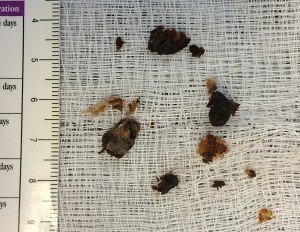 Along those lines, many people come to their ENT doctor each day because their ears are clogged with wax, also known as cerumen. Since people incessantly shove these cotton tips beauties in their ears, (which packs the cerumen in), they have to come in to have it removed. Take a look at this picture of all the cerumen that I removed from this guy’s ear canal! Remind you of Shrek? I realize that this blog is a family friendly blog, but if I have to see it — so do you.
Along those lines, many people come to their ENT doctor each day because their ears are clogged with wax, also known as cerumen. Since people incessantly shove these cotton tips beauties in their ears, (which packs the cerumen in), they have to come in to have it removed. Take a look at this picture of all the cerumen that I removed from this guy’s ear canal! Remind you of Shrek? I realize that this blog is a family friendly blog, but if I have to see it — so do you.
On a different note, I wanted to show you all some great pictures of my medical mission trip to Mekele, Ethiopia. You cannot miss this beautiful country if you travel to Africa. It is so beautiful and the people are as nice there as anywhere in the world.

This young lady is preparing the most delicious coffee you’ve ever tasted. Were you aware that Ethiopia is the birthplace of coffee? In the 10th century, Ethiopian mountain people are thought to have been the first to recognize that coffee had a stimulating effect. They didn’t drink the coffee though; they ate the red cherries directly from the tree. Coffee then spread throughout the Middle East, beans spread to Europe. Ultimately, coffee made it to Indonesia and the Americas.
Jerald S. Altman, M.D. is an Otolaryngologist-Head and Neck Surgeon (ENT doctor) and is the coauthor of Don’t Stick Sticks Up Your Nose! Don’t Stuff Stuff In Your Ears! He was recognized as a Phoenix Top Doc in 2010, 2011, 2012, and 2013. Dr. Altman loves taking care of children’s ear, nose, and throat issues. After publishing many peer-reviewed journal articles, he recognized the need for a children’s book dealing with a common problem in his practice.
Check out our website at www.dontstickdontstuff.com. Follow @dontstickdont on Twitter and “Like” us at Don’t Stick Sticks Up Your Nose! Don’t Stuff Stuff In Your Ears! on Facebook. For questions, contact Dr. Altman at Jerry@dontstickdontstuff.com

The post Cleaning Your Ears Safely – No Qtips In Your Ears! appeared first on .
December 17, 2014
Kids Holiday Craft Safety! (and a Buddha Hand)
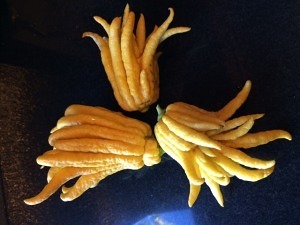
Today I wanted to show all of you 3 fruits from our 2 year old tree, called a Buddha Hand Citron. These fascinating looking and uber-fragrant citrus grow on a tree similar to other lemon trees. The difference is that the segments are already opened and each segment or “finger” is covered with the skin or exocarp as it is called. There is very little pulp inside the fruit, so they can be used for candy making, to zest onto food or in drinks, or simply just to look at. Aren’t they cool looking? You should smell them!
Speaking of 2 year olds, this time of the year many kids will be doing craft projects. With that, particularly with the young kids, parents and grandparents have to be vigilant about watching them as they use craft items. Beads are a big problem, but small buttons, cotton, paper and playdough can find their way into kids ears and noses. Besides watching them as they play and create, don’t forget to get down on your knees – at the kid’s eye level– and see dangerous items that they see, but you may have missed.
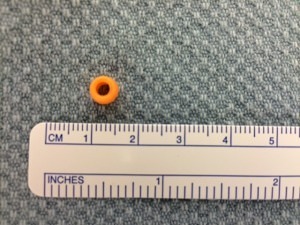 Kids of all ages can put items in ears and noses. Take a look at the bead here. This is from a 10 year old’s left ear. It could not be removed by the doctor in the Emergency room or by the pediatrician. I also couldn’t remove it in my office either, while the child moved around. It was too painful. So he had to be taken to the operating room, given general anesthesia and then I could remove the bead. But wait… there’s more! The bead that is shown to the left is the second bead; there were 2 beads in this kid’s ear. The first one was a silver bead and because it had been in there for several days, the ear canal swelled around in, so it wasn’t possible to get it out while the child was awake. (I lost the silver bead before I could take the picture because it fell down the drain when I cleaned it in the sink). The frosting on the cake is that this 10 year old boy also put a bead into his 5 year old sister’s ear! The pediatrician retrieved that one.
Kids of all ages can put items in ears and noses. Take a look at the bead here. This is from a 10 year old’s left ear. It could not be removed by the doctor in the Emergency room or by the pediatrician. I also couldn’t remove it in my office either, while the child moved around. It was too painful. So he had to be taken to the operating room, given general anesthesia and then I could remove the bead. But wait… there’s more! The bead that is shown to the left is the second bead; there were 2 beads in this kid’s ear. The first one was a silver bead and because it had been in there for several days, the ear canal swelled around in, so it wasn’t possible to get it out while the child was awake. (I lost the silver bead before I could take the picture because it fell down the drain when I cleaned it in the sink). The frosting on the cake is that this 10 year old boy also put a bead into his 5 year old sister’s ear! The pediatrician retrieved that one.

During this holiday season, just remember to watch the kids as they play and particularly when they are working with craft projects. Now is not the time to visit your doctor if a wayward bead or something makes its way into your child’s ear or nose.
Have a Happy Holiday Season!
Jerald S. Altman, M.D. is an Otolaryngologist-Head and Neck Surgeon (ENT doctor) and is the coauthor of Don’t Stick Sticks Up Your Nose! Don’t Stuff Stuff In Your Ears! He was recognized as a Phoenix Top Doc in 2010, 2011, 2012, and 2013. Dr. Altman loves taking care of children’s ear, nose, and throat issues. After publishing many peer-reviewed journal articles, he recognized the need for a children’s book dealing with a common problem in his practice.
Check out our website at www.dontstickdontstuff.com. Follow @dontstickdont on Twitter and “Like” us at Don’t Stick Sticks Up Your Nose! Don’t Stuff Stuff In Your Ears! on Facebook. For questions, contact Dr. Altman at Jerry@dontstickdontstuff.com
The post Kids Holiday Craft Safety! (and a Buddha Hand) appeared first on .



